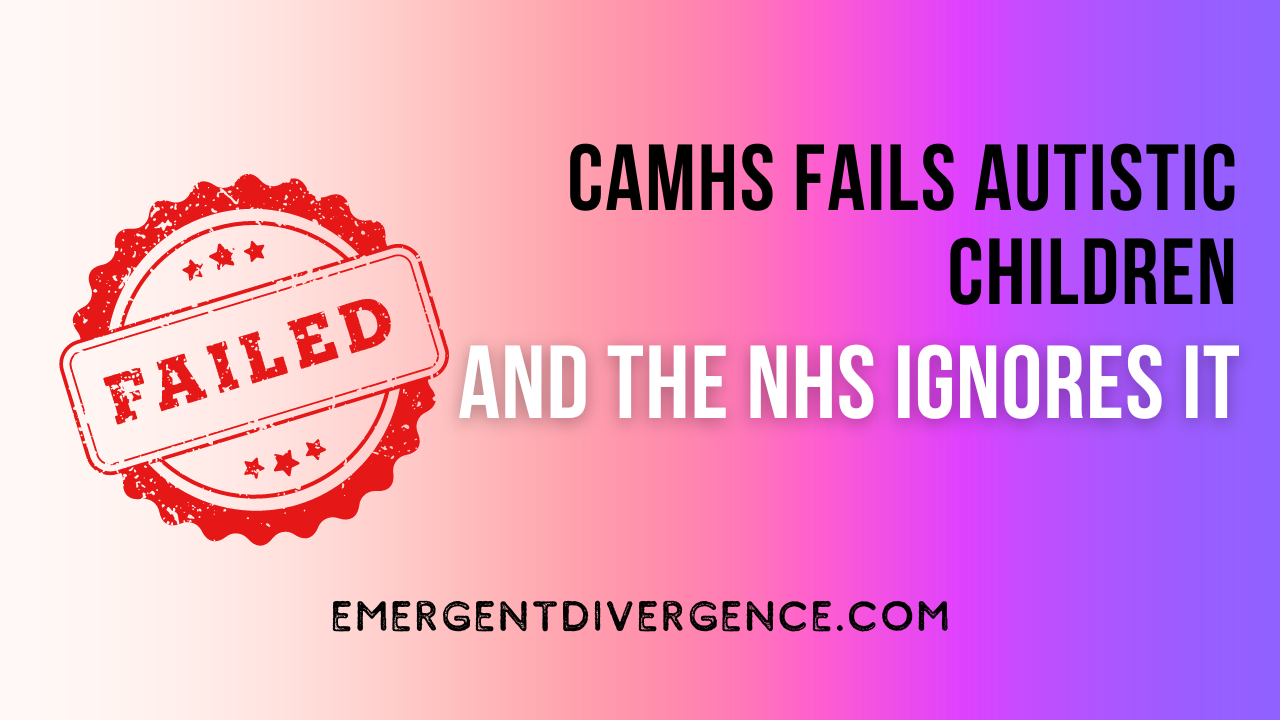CAMHS Fails Autistic Children, and the NHS ignores it
It seems that with increasing regularity I come across more and more evidence that Child and Adolescent Mental Health Services (CAMHS) failing of Autistic people is well known. Despite this, very little action seems to be take to correct this major risk. The government is aware, and it seems as though the NHS itself is also aware. The following is commentary on a report from Child & Family Health Devon (CFHD), taken off of the NHS website. The question to be answered by the report by Research Inspired by Service Experts (RISE) was:
“How does having a diagnosis of a neurodiverse (sic) condition affect CAMHS practitioners’ decisions about mental health treatment?”
CAMHS RISE report
Please note that the word “neurodiverse” is used incorrectly throughout the report, however, I will be using direct quotes. Often the word they should be using is “neurodivergent”.

“Little Evidence” of CAMHS tailoring treatments to neurodivergent children
“Even though many CAMHS users are neurodivergent, there is little evidence to show that CAMHS practitioners tailor treatment options for these children and young people. Instead, the approach is standardised for the mental health condition which can lead to problems with accessibility and inappropriate interventions.”
CAMHS RISE report
It has been highlighted in government reports that treatments provided within CAMHS are often developed by people who lack insight into Autistic and neurodivergent experience. Linden et al (2023) found there is a great deal of uncertainty around whether or not traditional treatments for anxiety and depression are effective for Autistic people. Evidence for treatments of depression appears to be quite weak (Menezes, 2020), Loizou et al (2023) finding that while treatments can be adapted to make a bespoke package of care, more research is needed.
Inappropriate mental health treatment makes mental health worse
“One study looking at the experiences of autistic CAMHS users found that mainstream interventions that were not modified for the young person’s autism were often unsuccessful in improving their mental health, or in some cases, made symptoms worse.”
CAMHS RISE report
The study in question is Read & Schofield (2010). The research again highlights the need for services to be adapted to the unique needs of Autistic individuals. This lack of adaptation is, in my opinion, a combination of under-resourced services, coupled with the double empathy divide between professionals and service users. Simply put, professionals rarely appreciate how inappropriate treatments are because they have no point of reference within Autistic and neurodivergent experience. Even if they did, services lack the resources to create something suitable.
CAMHS staff are “unwilling” to adapt treatments to Autistic children
“Other studies have also commented on the inability or unwillingness of mental health practitioners to tailor approaches to support the needs of those with an Autism Spectrum Condition (ASC) diagnosis.”
CAMHS RISE report
The study referred to here is Adams & Young (2020). This highlights to me the broader ableism within mental health treatment where disable children are being expected to meet a normative standard, rather than treatment being adapted to their needs. Research has indicated that ableist microagressions negatively impact outcomes in mental health treatment (Kattari, 2020). Autistic and neurodivergent children exposed to ableism are also likely to internalise ableist opinions which can have a lasting impact on their wellbeing. Internalised ableism can lead to social exclusion and marginalisation (Jóhannsdóttir et al, 2022).
How can CAMHS change for the better?
The prevailing theme throughout the research and the report is of a need for taking a different approach to Autistic and neurodivergent people. While adapting mental health treatments may be of some efficacy, services like CAMHS need to encourage further research to make sure that adaptations are helpful rather than harmful.
There also needs to be a distinct change in professional culture and attitudes to alleviate the impact of the double empathy divide, and professional ableism. Disabled service users deserve equitable access to resources that help them without causing further harm. Until this can be done, it is likely that CAMHS will remain a service that can not appropriately support many of it’s neurodivergent service users.
Use these buttons to support this campaign.
References
Adams, D., & Young, K. (2021). A systematic review of the perceived barriers and facilitators to accessing psychological treatment for mental health problems in individuals on the autism spectrum. Review Journal of Autism and Developmental Disorders, 8(4), 436-453.
Jóhannsdóttir, Á., Egilson, S. Þ., & Haraldsdóttir, F. (2022). Implications of internalised ableism for the health and wellbeing of disabled young people. Sociology of health & illness, 44(2), 360-376.
Kattari, S. K. (2020). Ableist microaggressions and the mental health of disabled adults. Community Mental Health Journal, 56(6), 1170-1179.
Linden, A., Best, L., Elise, F., Roberts, D., Branagan, A., Tay, Y. B. E., … & Gurusamy, K. (2023). Benefits and harms of interventions to improve anxiety, depression, and other mental health outcomes for autistic people: A systematic review and network meta-analysis of randomised controlled trials. Autism, 27(1), 7-30.
Loizou, S., Pemovska, T., Stefanidou, T., Foye, U., Cooper, R., Kular, A., … & Johnson, S. (2023). Approaches to improving mental health care for autistic people: a systematic review. MedRxiv, 2023-03.
Menezes, M., Harkins, C., Robinson, M. F., & Mazurek, M. O. (2020). Treatment of depression in individuals with autism spectrum disorder: A systematic review. Research in Autism Spectrum Disorders, 78, 101639.
Read, N., & Schofield, A. (2010). Autism: are mental health services failing children and parents? Recent research suggests that many CAMHS need to improve. Journal of Family Health Care, 20(4), 120-125.








You must be logged in to post a comment.